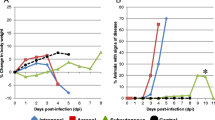Summary
Spread of Venezuelan equine encephalitis (VEE) virus and damage of the central nervous system (CNS) in mice infected by respiratory route was studied. Virus concentration in organs and blood, “dose-effect” relationships, and ultrastructural lesions in various tissues were examined in immune and normal mice. We showed, via three independent methods — characteristic curve investigations, tissue virus concentration dynamics, and ultrastructural methods — the spread of VEE virus through the olfactory tract into the brain of immune mice. From these experiments it was concluded that in case of respiratory challenge VEE virus can enter the CNS of normal mice by both vascular and olfactory pathways, while in immune mice the main route is olfactory.
Similar content being viewed by others
References
Albrecht P (1968) Pathogenesis of neurotropic arbovirus infection. Curr Top Microbiol Immunol 43: 44–91
Berge T, Banks I, Tigertt W (1961) Attenuation of Venezuelan equine encephalitis virus by in vitro cultivation in guinea pig heart cells. Am J Hyg 73: 209–211
Borovkov AA (1984) Matematicheskaya statistika (Mathematical statistics). Nauka, Moskva [in Russian]
Cancalon P, Brady ST, Lasek RJ (1988) Slow transport in a nerve with embrionic characteristics, the olfactory nerve. Dev Brain Res 38: 275–285
Cole GJ, Elam JS (1983) Characterization of axonally transported glykoproteins in regenerating garfish olfactory nerve. J Neurochem 41: 691–702
Cook ML, Stevens JG (1973) Pathogenesis of herpetic neuritis and ganglionitis in mice. Infect Immun 7: 272–288
Danes L, Kufner J, Hruskova J, Rychterova V (1973a) The role of olfactory pathway in respiratory tract VEE infection of normal and operated Macaca rhesus. I. Results of virological studies. Acta Virol 17: 50–56 [in Russian]
Danes L, Rychterova V, Kliment V, Hruskova J (1973b) Penetration of Venezuelan equine encephalitis virus into the brain of guinea pigs and rabbits after intranasal inoculation. Acta Virol 17: 138–146 [in Russian]
Davis NL, Grieder FB, Smith JF, Greenwald GF, Valenski ML, Sellon DC, Charles PC, Johnston RE (1994) A molecular genetic approach to the study of Venezuelan equine encephalitis virus pathogenesis. In: Brinton MA, Calisher CH, Rueckert RR (eds) Positive-strand RNA viruses. Springer, Wien New York, pp 99–109 (Arch Virol [Suppl] 9)
Grimley PM, Berezesky SK, Friedman RM (1968) Cytoplasmic structures associated with arbovirus infection: foci of viral ribonucleic acid synthesis. J Virol 2: 1326–1338
Guyton AC (1947) Measurement of respiratory volumes of laboratory animals. Am J Physiol 150: 70–77
Jackson AC, SenGupta SK, Smith JF (1991) Pathogenesis of Venezuelan equine encephalitis virus infection in mice and hamsters. Vet Pathol 28: 410–418
Jahrling PB, Stephenson EH (1984) Protective efficacies of live attenuated and formaldehyde-inactivated Venezuelan equine encephalitis virus vaccines against aerosol challenge in hamsters. J Clin Microbiol 19: 429–431
Johnson RT (1964) The pathogenesis of herpes virus encephalitis. I. Virus pathways to nervous system of suckling mice demonstrated by fluorescent antibody staining. J Exp Med 119: 343
Kaluza G, Lell G, Reinacher M, Stits L, Willems WR (1987) Neurogenic spread of Semliki Forest virus in mice. Arch Virol 93: 97–110
Monath TP, Cropp CB, Harrison AK (1983) Mode of entry of a neurotropic arbovirus into the central nervous system. Reinvestigation of an old controversy. Lab Invest 48: 399
Reinacher M, Bonin J, Narayan O, Scholtissek C (1983) Pathogenesis of neurovirulent influenza A virus infection in mice. Route of entry of virus into brain determines infection of different populations of cells. Lab Invest 49: 686–692
Sachs L (1972) Statistische Auswertungsmethoden. Springer, Berlin Heidelberg New York
Sergeev AN, Ryzhikov AB, Bulychev LE, Stepkina EO, Tkacheva NV (1991) Techenie infektsii u krolikov, aerogenno zarazhennykh virusom venesuel'skogo entsefalomieltia loshadei (The course of airborne infection in rabbits infected with the Venezuelan encephalomyelitis virus). Vopr Virusol 36: 492–495 [in Russian]
Stephenson EH, Moeller RB, York CG, Young HW (1988) Nose-only versus whole-body aerosol exposure for induction of upper respiratory infections of laboratory mice. Am Ind Hyg Assoc J 49: 128–135
Taguichi F, Goto Y, Aiuchi M, Hayashi T, Fujiwara K (1979) Pathogenesis of mouse hepatitis virus infection. The role of nasal epithelial cells as a primary target of low-virulence virus, MHV-S. Microbiol Immunol 23: 249–262
Author information
Authors and Affiliations
Rights and permissions
About this article
Cite this article
Ryzhikov, A.B., Ryabchikova, E.I., Sergeev, A.N. et al. Spread of Venezuelan equine encephalitis virus in mice olfactory tract. Archives of Virology 140, 2243–2254 (1995). https://doi.org/10.1007/BF01323243
Received:
Accepted:
Issue Date:
DOI: https://doi.org/10.1007/BF01323243




